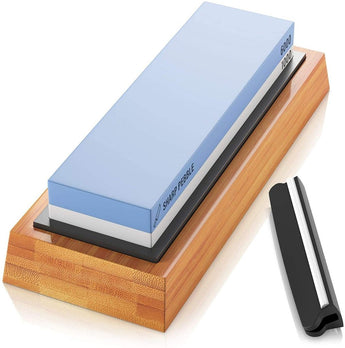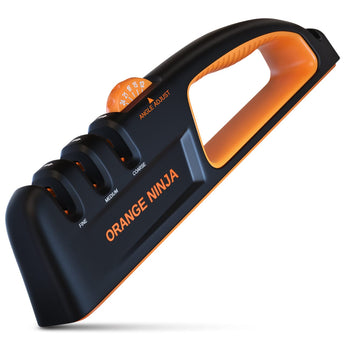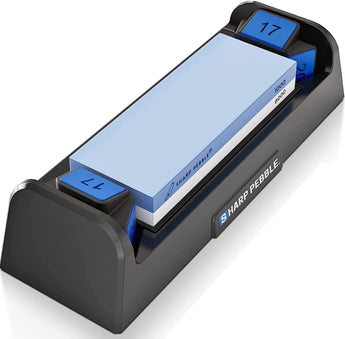
No one really wants to be pushing & grinding with a blunt knife, and you don’t really have to be a master sushi chef to want to work with a razor sharp knife. Not it doubles your work and makes your food look ugly but you’re much more likely to lose half a finger if you keep on insisting with a knife that isn’t sharp enough.
From sharpening steels to taking your knives to a professional sharpener and everything in-between; there are plenty of ways to sharpen your blades. Today, we’ll talk about whetstones. What they are, why you need them and how to use them properly.
What is it?
A whetstone is essentially a slab of stone (either natural or synthetic), that is used to sharp knives and other metal tools such as chisels or axes.
A bit of whetstone history
Also called water stones or sharpening stones; they have been known to be in use since 79 AD. It is thought that whetstones first emerged in areas such as Arkansas, Japan, and England because these lands had an abundance of naturally occurring stones ideal for sharpening metal.
Here’s another interesting bit; it is wrongly thought that whetstones are so called because they have to be lubricated with water. In fact, the basis of the word whetstone is the word “whet” which means to sharpen.
Why sharpening on a whetstone is a better choice?
As mentioned earlier, there are more than one ways to skin a cat. That said; using a whetstone seems to be one of the most popular knife sharpening methods among professionals and household kitchens alike. And there’s a good reason for that:
- If you’re a beginner and have just started to explore knives then using a whetstone is one of the easiest ways to learn to sharpen a knife.
- Whetstones give you a lot more control over how the edge turns out. The vast variety of stone grits allows you to decide the extent and speed of metal removal from the edge, giving you a lot more control as compared to what other knife sharpening methods offer.
- They aren’t very heavy on your wallet. Although there are whetstone varieties that may have a steep price tag; it’s easy to find synthetic options these days that are cheap and will do a fine job sharpening that knife of yours.
- They’re low maintenance. Yes indeed; that’s another reason to choose a whetstone as your primary knife sharpener. Most of them just need to be soaked in clean tap water for a few minutes before use and they’re good to go!
Important factors to consider
- You’ll need more than one grit: There are several aspects that need focus in order to achieve a properly sharpened blade. Each of these aspects is best served by a relevant grit. Grit is the measure of a sharpening stone’s coarseness.
To start off you need a coarse stone. Sharpening essentially is a process of getting a good blade shape and then progressively refining it to achieve the desired result. Using a coarse stone will help you get your blade in better shape in the shortest possible time.
Although a knife sharpened on a coarse stone will indeed perform better than a blunt one but it won’t be as efficient as a proper blade should be. That is where “refining” comes in. Refining refers to the process of conditioning the blade so it delivers the sharpest possible cut.
Now we’re sure you’re asking if a fine stone can get the job done on its own or you need the coarse stone as well. You see, the finer stone performs “one of the aspects” of sharpening, the other aspect is bringing back the dull blade to life, which a coarse stone does.
In theory, you could sharpen a completely dull knife with a fine grit stone but that’s not practical because the amount of metal removed by the fine stone is a lot less than what the coarse stone can. It will take you ages to sharpen a dull blade with only a fine grit stone. So we recommend having both coarse and fine grit stones.
- The Correct Size: The key factor here is the type and size of the tool that you need to sharpen. There are several sizes available but a size of 7-8 inches is considered handy for most sharpening jobs. You may also find small stones in lengths of 3-4 inches but they are primarily for travel purposes and not ideal for everyday use.
For knife sharpening, it’s more practical to opt for longer stone. The length will expedite the sharpening process since it requires fewer strokes. If you’re unsure about length, always opt for the longer option since a smaller knife is much easier to sharpen on a longer stone than a longer knife on a shorter stone.
Some handy tips to sharpen with a whetstone:
Be sure to incorporate these tips while sharpening your knives. Not only will you have sharper knives but your whetstones will wear better, last longer and your job will become a lot easier.
- Usually, rookies tend to follow a haphazard sharpening pattern. It’s best to sharpen in the same direction i.e. either front-to-back or back-to-front.
- You may have heard about super-blades that don’t need sharpening. That’s rubbish! It’s like saying your car can run for 50 years without proper maintenance. Cutting means friction, which over time reduces a blade’s sharpness. That’s physics, which we can’t go around.
- Ceramic knives aren’t meant for sharpening; they aren’t strong enough to withstand the constant pressure of sharpening and are likely to break.
- Lastly, proper storage and cleaning also play an important role in ensuring your knife’s longevity. When your knives aren’t being used, store them in a way that doesn’t put any direct pressure on their edge. Run them under clean water after each use. And wait for them to dry properly before putting them away so there isn’t any rust formation.
We’d love to hear from you! Drop us a PM on our Facebook or Instagram. For more useful tidbits on sharpening be sure to visit our blog.
References



